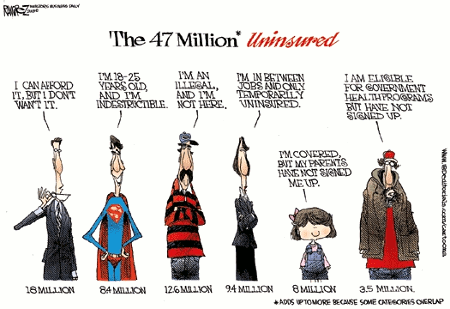1. More Evidence of the Fall, Item #11: a man walks into a fitness center, turns off the lights and sets his gun to blazing. The cowardly shooter (since shooters like this often seek fame in death, I will not mention his name) went straight to an aerobics class and opened fire with multiple handguns. He may have been seeking out his girlfriend; most of the injured were women; four died. We should pray for the victims and their families.
2. It appears increasingly certain that the “public option” as well as the private plans subsidized through the health care reform being debated in Congress would assure that federal funds–that is, tax dollars collected from every American who pays any kind of tax–will go to provide abortions. Lois Capps, D.-Calif., tried to work out a compromise in which abortions are not technically paid through the government but through beneficiary premiums, but some pro-lifers aren’t having it. “It’s a sham,” said Douglas Johnson, legislative director for National Right to Life. “It’s a bookkeeping scheme. The plan pays for abortion, and the government subsidizes the plan.”
3. Bill Clinton secures the release of two American reporters from North Korea. Whatever the machinations behind the scenes, and whether or not this was wise from a diplomatic and strategic point of view, we can all rejoice that these two women are coming home safely. As various commentators have remarked, Clinton would not have traveled to Pyongyang if the outcome were not virtually guaranteed and worked out in advance. It is also clearly false when the Obama administration claims that it had nothing to do with this. The release apparently “followed weeks of quiet negotiations between the State Department and the North Korean mission to the United Nations….’Clinton didn’t go to negotiate this, he went to reap the fruits of the negotiation.'”
What does this mean? I have to disagree with those who say that this was about giving the Kim regime “a way to save face.” The Kim regime did not mistakenly kidnap these reporters, mistakenly condemn them, mistakenly imprison them–and then need to be spared their embarrassment. They, in the midst of international and internal posturing, took these two reporters in order to use them as bargaining chips. That much is clear. What did the Kim regime get in return for releasing Ling and Lee? For one thing, Kim got a photo op with former President Clinton, who is highly regarded in North Korea. This clearly strengthens the Kim regime at a moment in which it was tottering. Whether North Korea is also receiving other concessions under the table, we will have to wait and see. As Gordon Chang writes, let’s hope that the Obama administration did not give “undeserved concessions on North Korea’s nuclear program or an agreement to ignore the plight of the country’s numerous other detainees.”
One only hopes that we did not, as Chang says, “throw Kim a lifeline” at a point in time when, without our aid, his regime would have fallen.
Clinton agreed in 1994 to an arrangement in which North Korea would not develop nuclear weapons, in return for assistance in building nuclear power plants. Yet we discovered later that North Korea had in fact continued the development of nuclear weapons. The Kim regime had given assurances, and yet behind our backs they betrayed us. Clinton sits stiffly now in all the pictures with Kim, clearly unwilling to be caught on camera with a smile. One wonders what he is thinking.
4. A very strong conservative argument is emerging against Cash for Clunkers. One of the key paragraphs from the first article:
Cash for Clunkers…[is] a simple subsidy, in which taxpayers who aren’t selling clunkers subsidize people who are buying new cars. Like all government subsidies, including government aid to the poor, C4C is horrendously inefficient. Various observers have pointed out that a great deal of that first billion dollars in funding disappeared into thin air. On top of the taxpayer loot being stolen and squandered, we must add the value of the cars being destroyed. The final cost of this initiative will be far more than the billions of taxpayer dollars Congress has voted to pump into it. Of course, that funding is more of Obama’s reckless deficit spending, so the final total must be marked up to include the titanic interest paid to service the debt.
And from the second article, which calls the C4C program an “unmitigated disaster” on every level:
A survey of car dealerships found a relatively small differential in fuel efficiency between cars traded in and those replacing them. A Reuters analysis concluded — even with the extended program in place — “cash for clunkers” would trim U.S. oil consumption by only a quarter of 1 percent.
As an economic stimulus, the plan is equally impotent. As James Pethokoukis, a columnist at Reuters, succinctly explained, “The program gets much of its juice via stealing car sales from the near future rather than generating additional demand.” The point of a stimulus should be to create new demand, not to move existing demand around to score political points…
If the nation weren’t in the midst of a six-month agenda of national redistribution, this kind of blatantly inefficient program — even if it were ostensibly about the environment — would be allotted a measure of substantive debate in Congress. No such luck. We need to pass something quickly — quickly, always quickly. And that kind of pressure typically manifests in some creative accounting.
This week, Secretary of Transportation Ray LaHood claimed that “cash for clunkers” had benefited domestic car companies, particularly Ford. When The Associated Press requested data to verify this contention, the most transparent administration ever to grace God’s soon-to-be-unblemished Earth refused to release the data. The AP reported that “the limited information released so far shows most buyers are not picking Ford, Chrysler or General Motors vehicles, and six of the top 10 vehicles purchased are Honda, Toyota and Hyundai.”
Still, on balance it seems to me that this is one of the less egregious uses of money in the current “stimulus” program. The environmental effect of destroying the old cars is so miniscule that it can only be considered a sop to environmentalists, not a meaningful environmental measure, and since that is so, the destruction of the old vehicles seems counterproductive, especially when those vehicles could be made available cheaply to the poor. It would probably be better if those $3B were never taxed; but, once they’re taxed and marked for “stimulus” distribution, this is one of the less boneheaded ways of doing it.
5. After excoriating executives of auto companies for using private planes when their companies were suffering, the Congress has ordered up 3 new jets to ferry them and other Washington brass around the country. The Air Force, which provides the service for government and military leaders, had requested one new plane. Congress gave themselves three.
6. Not everyone will agree with me on this, but I find it deeply disheartening that the Obama administration has acknowledged Ahmadinejad as “the elected leader” of Iran. This was no election, as anyone with a brain knows. The press secretary and the President have brains, of course, so they know this full well. It’s possible that this reflects some of their back-door conversations with Iran (“publicly recognize me as the elected leader of Iran, and I’ll be more receptive to your overtures). Regardless, whatever the calculations, this is a travesty to the truth and a failure to stand up for justice. To my mind, at least, the Obama administration just stabbed all those protestors in the back. At the same time, Iran announces that the American hikers they picked up in the mountains between Iran and Iraq will be tried for espionage.
7. The discussion on health care continues to refer to 45, 48 or 50 million “uninsured.” None of this changes the fact that everyone should have health insurance or at least access to health insurance they can afford. But those numbers refer to individuals who at any point within the year did not have health insurance. Roughly 50% are transitional; they will find new insurance within 4 months, since many are in-between employers, or just graduating from college, or just left the military. Roughly 10 million of the “uninsured” are illegal immigrants; many illegal immigrants are eligible for coverage through employers or anonymous government programs, but do not enroll. Many of those who do not enroll go to emergency rooms when they have major or minor medical problems, and those emergency rooms are required to treat them. So many do receive medical care, and could receive better medical care if they enrolled. Of the roughly 25 million who are uninsured for the whole year, 7 million are illegal immigrants.
Roughly 1 in 4 of the uninsured are eligible for Medicaid or SCHiP, but are not enrolled for whatever reason. Some think those who are eligible for Medicaid should be counted as insured, because at the time of need (a car accident, say), they can apply and receive coverage, or receive reimbursement retroactively. Still, they’re counted as uninsured because they’re not enrolled. Roughly 1 in 5 have an income about $55,000 and could presumably afford health care. About 9 or 10 million are children. Some of these are eligible for SCHiP, but their parents have not enrolled them.
None of this means we don’t need health care reform. Cartoonist Michael Ramirez picked a different year for his figures, and sliced up the pie in some different ways, but here is his representation:
 Again, I am not saying that illegal immigrants should not have access to health insurance, or that there does not remain a significant number of people who cannot afford adequate health care. But one just wishes that these grand numbers weren’t thrown around so indiscriminately.
Again, I am not saying that illegal immigrants should not have access to health insurance, or that there does not remain a significant number of people who cannot afford adequate health care. But one just wishes that these grand numbers weren’t thrown around so indiscriminately.
8. Today’s Two Sides. The vaunted Arthur Laffer offers a critique of Obamacare and an alternative. John David Lewis, a Duke professor, also has a very effective critique, agreeing to my objection to the “rights” language. Michael Cohen thinks the President should talk more about shared sacrifice for the greater good. John Stossel finds a lot of empty promises. And Jay Cost at RealClearPolitics examines the political blunders committed by the administration and Congress thus far.











